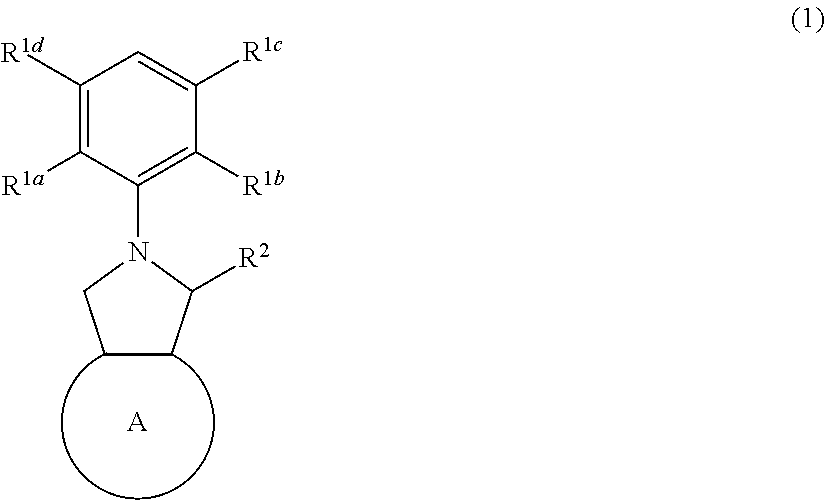Fullerene derivative and n-type semiconductor material
- Summary
- Abstract
- Description
- Claims
- Application Information
AI Technical Summary
Benefits of technology
Problems solved by technology
Method used
Image
Examples
synthesis example 1
Synthesis of Compound 1
[0164]
[0165]2-fluorobenzaldehyde (62 mg, 0.5 mmol), N-phenylglycine (151 mg, 1 mmol) and C60 fullerene (350 mg, 0.5 mmol) were stirred in 100 mL of toluene at 120° C. for 15 hours. After cooling, the solvent was distilled off, and the reaction product was separated by column chromatography (SiO2, n-hexane:toluene=20:1 to 5:1) to obtain Compound 1 (72.1 mg, yield: 15.4%). Compound 1 was further purified by preparative GPC (chloroform).[0166]1H-NMR (CDCl3) δ: 5.09 (1H, d, J=9.9 Hz), 5.65 (1H, d, J=9.9 Hz), 6.61 (1H, s), 7.02-7.18 (3H, m), 7.20-7.28(2H, m), 7.28-7.42 (4H, m), 7.84 (1H, d-d, J=6.3, 6.3 Hz). 19F-NMR (CDCl3) δ: −114.0-−115.5 (m).[0167]MS (FAB) m / z 934 (M+1). HRMS calcd for C74H413FN 934.1032; found 934.1023.
synthesis example 2
Synthesis of Compound 2
[0168]
[0169]2-thiazole carbaldehyde (56 mg, 0.5 mmol), N-phenylglycine (76 mg, 0.5 mmol), and C60 fullerene (175 mg, 0.25 mmol) were stirred in 100 mL of toluene at 120° C. for 62 hours. After cooling, the solvent was distilled off, and the reaction product was seprated by column chromatography (SiO2, n-hexane:toluene=1:1 to toluene) to obtain Compound 2 (95 mg, yield: 41%). Compound 2 was further purified by preparative GPC (chloroform).[0170]1H-NMR (CDCl3) δ: 5.27 (1H, d, J=9.9 Hz), 5.78 (1H, d, J=9.9 Hz), 6.91 (1H, s), 7.06 (1H, t, J=7.1 Hz), 7.30-7.46 (5H, m), 7.84 (1H, D, J=3.2 Hz).[0171]MS (FAB) m / z 922 (M+). HRMS calcd for C71H10N2S 922.0565; found 922.0562.
synthesis example 3
Synthesis of Compound 3
[0172]
[0173]C60 fullerene (360 mg, 0.5 mmol), benzaldehyde (212 mg, 2 mmol), and N-(2,6-difluorophenyl)glycine (187 mg, 1 mmol) were stirred in chlorobenzene (100 mL) at 130° C. for 4 days. After cooling, the solvent was distilled off, and the reaction product was separated by silica gel column chromatography (n-hexane:toluene=20:1 to 5:1) to obtain Compound 3 (108 mg, yield: 22.8%). Compound 3 was further purified by preparative GPC (chloroform).[0174]1H-NMR (CDCl3) δ: 5.12 (1H, d, J=9.1 Hz), 5.26 (1H, d, J=9.1 Hz), 6.46 (1H, s), 6.96 (2H, t, J=8.7 Hz), 7.12-7.35 (4H, m), 7.77 (2H, d, J=7.5 Hz).[0175]19F-NMR (CDCl3) δ: −117.06-−117.15 (m).[0176]MS (FAB) m / z 951 (M+). HRMS calcd for C74H11F2N 951.0860; found 951.0861.
PUM
 Login to View More
Login to View More Abstract
Description
Claims
Application Information
 Login to View More
Login to View More - R&D
- Intellectual Property
- Life Sciences
- Materials
- Tech Scout
- Unparalleled Data Quality
- Higher Quality Content
- 60% Fewer Hallucinations
Browse by: Latest US Patents, China's latest patents, Technical Efficacy Thesaurus, Application Domain, Technology Topic, Popular Technical Reports.
© 2025 PatSnap. All rights reserved.Legal|Privacy policy|Modern Slavery Act Transparency Statement|Sitemap|About US| Contact US: help@patsnap.com



